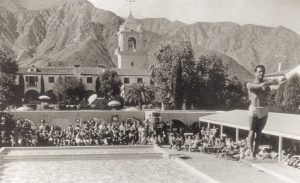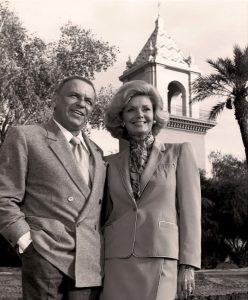About Us
Cornerstone of the Community for Seven Decades
Desert Regional Medical Center has deep roots in the greater Palm Springs community. The 385-bed acute care hospital is proud of its long-standing tradition of offering advanced care and comprehensive services, including life-saving trauma care, comprehensive stroke services, neurosurgery, cardiac surgery, cancer treatment, and neonatal intensive care services. Desert Regional Medical Center also has:
- Only Level 1 Trauma Center in the Coachella Valley (highest possible)
- Highest Level NICU in the Coachella Valley (Level III)
- Only Comprehensive Stroke Center in Coachella Valley
- The Comprehensive Cancer Center at Desert Regional
- Inpatient and outpatient surgery centers
- Acute Rehabilitation
Because it provides a higher level of care, Desert Regional takes some of the sickest and most critically-injured patients from other hospitals throughout Riverside, San Bernardino, Imperial and San Diego counties as well as parts of Arizona and Nevada.
Desert Regional is also a teaching facility, training the next generation of physicians. Some will remain in the community to help meet the increasing demand for healthcare services resulting from the area’s significant population growth. The hospital began residency programs in various specialties in 2014. The first class of family medicine residents graduated in June 2018.
From Glamorous Hotel to Wartime Hospital
 Prior to being the Level 1 Trauma Center it is today, Desert Regional Medical Center was once the glamorous El Mirador Hotel. The 165-room luxury hotel opened on New Year's Eve in 1928, serving the likes of Hollywood stars and socialites of the
20's and 30's. Frequent visitors included Albert Einstein, Bing Crosby, and Shirley Temple, along with journalists and photographers. The El Mirador Hotel, which roughly translates to "The Watchtower," was known for its 68-foot bell tower. This iconic
tower still stands on the hospital grounds today, albeit rebuilt from the original architectural blueprints after it burned down in 1989.
Prior to being the Level 1 Trauma Center it is today, Desert Regional Medical Center was once the glamorous El Mirador Hotel. The 165-room luxury hotel opened on New Year's Eve in 1928, serving the likes of Hollywood stars and socialites of the
20's and 30's. Frequent visitors included Albert Einstein, Bing Crosby, and Shirley Temple, along with journalists and photographers. The El Mirador Hotel, which roughly translates to "The Watchtower," was known for its 68-foot bell tower. This iconic
tower still stands on the hospital grounds today, albeit rebuilt from the original architectural blueprints after it burned down in 1989.
The hotel entered a new era in 1942 when the U.S. joined World War II. The Army bought El Mirador Hotel and subsequently converted it into the 1,600-bed Torney General Hospital, treating wounded soldiers from WWII conflicts around the globe.
Desert Hospital & Frank Sinatra: An Unexpected Benefactor
 In 1948, the 38-bed Palm Springs Community Hospital would be built on the former El Mirador campus. In 1951, the facility was renamed Desert Hospital, as part of the
publicly supported Desert Hospital District. Community philanthropist and famous musician Frank Sinatra was a key donor to the hospital for decades. In 1968, Sinatra announced a $500,000 donation to build what is now the hospital's Sinatra Education
Center. At the time it was called the single-largest financial contribution to a hospital made by an individual donor.
In 1948, the 38-bed Palm Springs Community Hospital would be built on the former El Mirador campus. In 1951, the facility was renamed Desert Hospital, as part of the
publicly supported Desert Hospital District. Community philanthropist and famous musician Frank Sinatra was a key donor to the hospital for decades. In 1968, Sinatra announced a $500,000 donation to build what is now the hospital's Sinatra Education
Center. At the time it was called the single-largest financial contribution to a hospital made by an individual donor.
Frank Sinatra and his wife, Barbara Sinatra, went on to host many fundraisers for the hospital. Most famously were his Valentine's Day Love-Ins, the first raising $2 million in one night, and his film premiere of Come Blow Your Horn where proceeds benefitted the hospital.
The Sinatra Education Center is still in use today for its original intended purpose, housing a 218-seat auditorium for lectures, multiple classrooms and conference rooms, and a medical library with a dedicated medical librarian to assist physicians and residents. The hospital's north tower wing is also named after Frank Sinatra.
The Greater Palm Springs Area– A Great Place to Live as Well as Vacation
Palm Springs is one of nine desert resort cities that are part of the Coachella Valley, located in Riverside County, California. Nestled at the base of the San Jacinto Mountains, Palm Springs offers an average of 354 days of sunshine a year, beautiful scenery and plentiful recreational opportunities including golf, tennis, hiking, biking and swimming. Joshua Tree National Park is just a short drive away. Conveniently located in Southern California, Palm Springs is also just two hours from the beach and alpine mountain recreation is available right at home at the Palm Springs Aerial Tramway.
With a permanent population of more than 443,000, the greater Palm Springs area offers affordable housing—especially when compared to other areas of Southern California.
For residents with children, you’ll find excellent public and private schools. You’ll also discover a variety of fun activities for the whole family, including the Children’s Discovery Museum of the Desert, an ice skating rink, miniature golf, the Palm Springs Art Museum, art studios, the McCallum Theatre for the Performing Arts, The Living Desert Zoo and Gardens, a waterpark, Palm Desert Aquatic Center, bowling alleys, and casinos.
Higher education opportunities include the University of California Riverside’s Palm Desert Center, California State University San Bernardino’s Palm Desert Campus, and the College of the Desert, all of which offer an array of undergraduate and graduate opportunities. Several fields and levels of study are also available through the Chapman University System.
For entertainment, there’s never a shortage of things to do in the desert. Major events include PGA and LPGA Tour golf tournaments, the BNP Paribas Open tennis tournament, the legendary Coachella Fest and Stagecoach music festivals, La Quinta Arts Festival, Tamale Festival and more.
For shoppers, there are boutiques and unique offerings along Palm Canyon Drive in Palm Springs and the famed El Paseo Drive in Palm Desert, which hosts Fashion Week each March. The area also includes an indoor mall – the Westfield Shopping Center, as well as old town La Quinta and numerous big box retailers throughout the valley. For those looking for outlet shopping, the Desert Hills Premium Outlets boasts over 100 stores just 20 minutes from Palm Springs.
Visit these websites for more information about the Palm Springs area:

